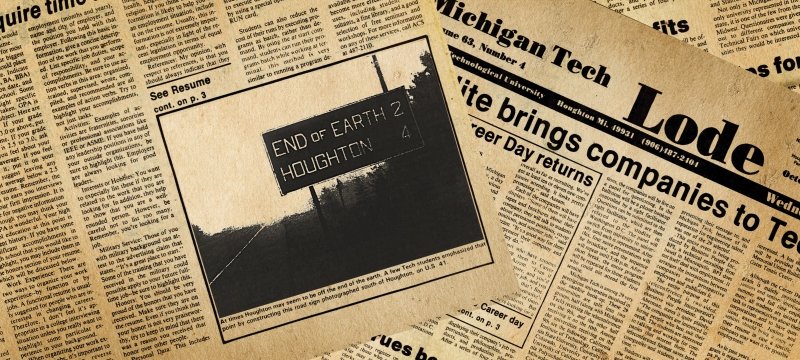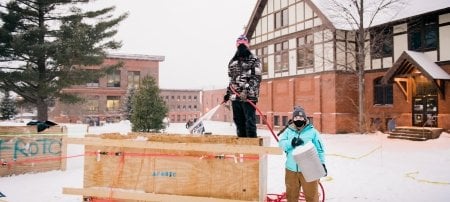Here’s the story behind the iconic End of Earth sign, told by the Michigan Tech students who pulled off the most enduring prank in University history.
It only stood for a few hours on the road between Houghton and Chassell, Michigan, but the legend lives on—in print and digitally, authorized and unauthorized. There’s something particularly unforgettable about the image. Maybe it’s the fog, which adds the quintessential eerie touch. Photographer Tim Cocciolone and fellow prankster John Marchesi agree the weather was pure luck. The only logistical detail they worked out in advance was the distance. As one might expect of Huskies, they logged the precise mileage for their project.
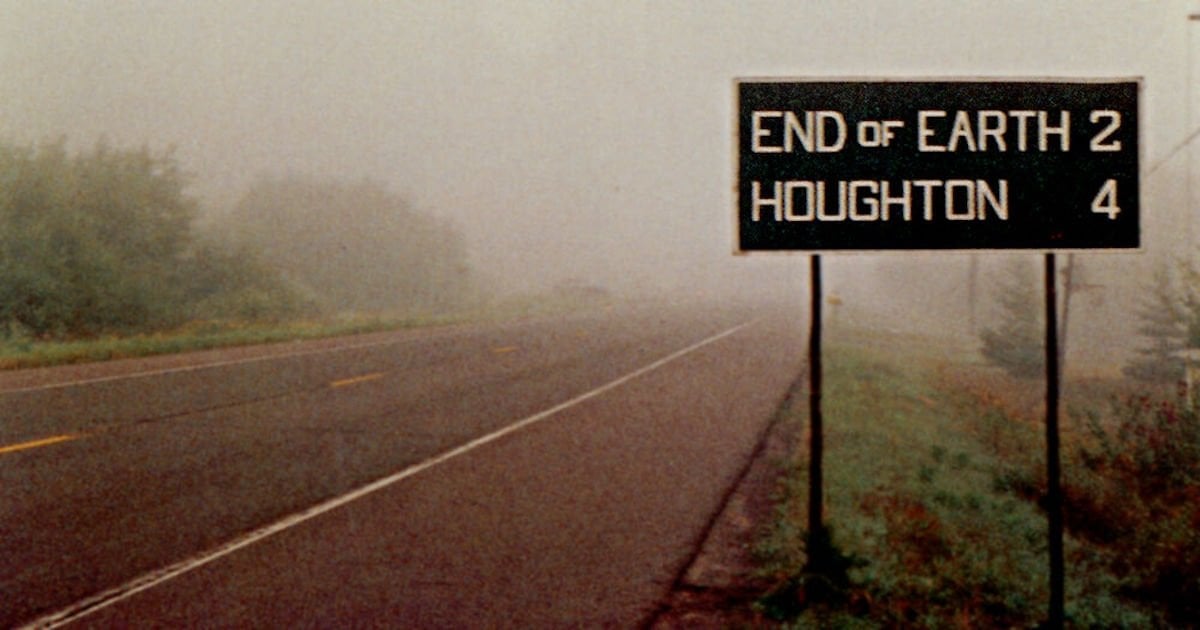
It wasn’t the first time the longtime friends cooked up a stunt. There had been plenty of practical jokes since they met in seventh-grade shop class in the Detroit area.
“Tim and I were always mischievous. We were always pulling pranks,” says Marchesi, a 1986 electrical engineering graduate. “He’s the only one I’ve ever called best friend.”
"The fog: It just happened. That sign, it was meant to happen—I’m just glad it was Tim and I, before Photoshop. It’s been kind of a cool ride."
“He is part of my family and I am part of his,” says Cocciolone, who transferred to Tech after attending the 1982 Winter Carnival but didn’t finish his coursework here.
For two years, the pair came up north early to nose around the Copper Country (they liked exploring the deserted towns and small communities). It also gave them time to settle in at MTU—and scheme.
To kick off the 1983 school year, they switched all the apartment numbers in MTU’s Daniell Heights housing complex. The 1984 sign scheme was more elaborate.
"It was a couple days before the freshmen came back. We thought we’d mess with them."
Poster Presentation Goes the Distance
“We made a big project out of it,” says Marchesi. “I had my little Chevette; we went out and measured for four miles from town.” They also measured an official Michigan Department of Transportation (MDOT) road sign for dimensions and letter size. The day before, they secured the signposts. “We went through the woods behind Daniell Heights and found trees to cut down,” Marchesi says, adding, “Beer may have been involved.”
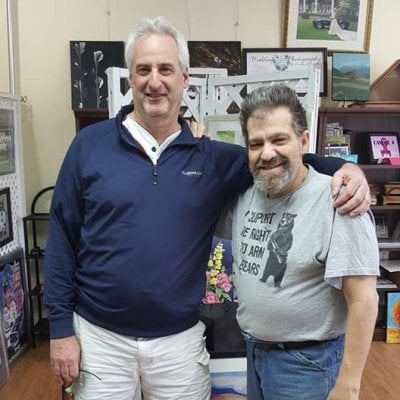
It cost $25 to make the sign. “Is that hardware store in the middle of downtown still there?” Marchesi asks, referring to Swift’s, which is indeed still a fixture in the center of the city. “That’s where we got the supplies: green and white paint and an eight-by-four particle board. We lugged it back to the apartment. Painted the whole thing white first and masked it.”
A couple of commercial sign painting side jobs from the previous summer made for a realistic rendering. The next morning, they again set off in the Chevette, positioning the sign on US-41. On that misty morning, Cocciolone took some photos before they took off. When the duo went to look (gloat?) over their handiwork a few hours later, the sign was gone.
They figured it had been stolen. They placed an ad in the Michigan Tech Lode.
A few days later, they got a call from Deputy Sid Collins at the Houghton County Sheriff Department asking them to come in and claim their sign. “We waited a better part of a week before we finally went to the police station,” says Marchesi. “We really thought we were gonna get arrested or in trouble. But we really wanted the sign back.” Unsmiling law enforcement officials sternly directed the two to wait in a windowless interrogation room. When Deputy Collins came in, the worried Huskies asked if they were in trouble.
“They told us they probably would have left it up if we hadn’t put it so close to the road,” says Marchesi. The two left the station with their sign, which was relegated to the basement of the Alpha Kappa Psi fraternity house, of which Marchesi was a member.
In the meantime, University and public reaction was snowballing thanks to a front page photo of the sign in the Michigan Tech Lode. “It must have been a slow news week,” Marchesi jokes.
Cocciolone recalls, “It was the first time there weren't enough copies of the Lode printed. Students were sending them home, and plastering the picture all over the dorm halls.”
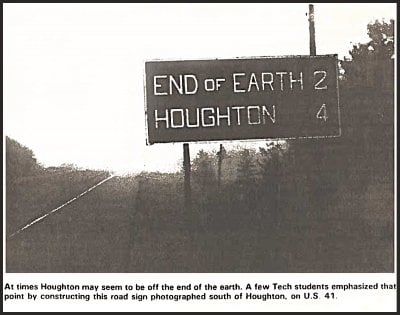
“One of my favorite stories is that one of my teachers, when the picture came out in the Lode, was so happy,” says Marchesi. “He saw the road sign driving to work and thought MDOT had a great sense of humor. He told people about it, but it was gone when they went to look for it. He was glad he had proof!”
The popularity of the front-page photo inspired the postcard, which wasn’t printed until a year later. From its debut, which garnered a front-page Milwaukee Journal interview, to today, the image continues to get a lot of exposure—including billboards, books, magazines, and a promotional City of Houghton video. One of Marchesi’s favorite references to the sign came from Jacques Cousteau, who visited Michigan Tech to talk about the wreck of the Edmund Fitzgerald. “When he made his opening remarks, he said, ‘When I came up here, I didn’t know it was the End of the Earth.’”
A Detroit newspaper columnist once wrote that the postcard purveyor had probably retired to Florida on his earnings. Not so, says Marchesi. But it did buy a perennially penny-pinching college student a steak dinner at the Library Restaurant in Houghton.
Husky Entrepreneurship is a Michigan Tech Tradition
The postcard, which is still sold at The Campus Bookstore and University Images, is indicative of the MTU spirit of innovation and hustle. “I got going on doing the postcards when I was doing my co-op at General Dynamics,” says Marchesi. “It was $300 to make 3,000 postcards priced at 25 cents apiece. They sold out in two weeks.”
He walked around town, pitching to local business, but Marchesi didn’t get a particularly warm reception at the MTU Bookstore.
“They weren’t that interested that I was selling postcards until I showed it to them,” he says. “As soon as they saw it they took 100. By the end of the day I had $37.50 on me. I had my first steak since college and two glasses of chianti at The Library. That was huge money for me in college. Everybody was calling by the time I got back to the frat house,” he says. “They’d sold out. I delivered the rest and ordered 4,000 more. Those sold out pretty quick, too. Funded spring break.”
Marchesi’s uncle eventually took over printing the postcards after the first two printing companies doing the job went out of business. He’s still the supplier. In all, more than 40,000 copies have been sold. “We go through a few thousand a year,” Marchesi says.
"I’ve had people approach me—there’s places all over the country that could fit that bill. You think you could re-create the sign somewhere else. You can’t. There’s something unique about the area. The reality is, Tech’s special. It means something."
“The image has been stolen a lot,” Marchesi adds. “After a while, we kinda looked at it as a form of flattery—that we came up with something that somebody wants to steal.” The End of the Earth image continues to be pirated. “Sweatshirts. Mousepads. It’s not going to make or break my life. It’s cool that it lives on,” says Marchesi. “It’s part of the culture. It’s a great way to describe Tech.”
Marchesi continues to nurture his entrepreneurial spirit. “It’s not the only thing I ended up printing,” he says. “You create something and you market it. It’s not that easy to find something that nobody else has done and take it to the next step. It doesn’t matter if you make a lot of money, it’s that you tried. And it benefits your life in other areas.”
While some of his projects, including boxed poker decks for specific styles of play, have enjoyed modest success, he doesn’t believe there will ever be another End of the Earth.

On Life’s Highway, Houghton is a Destination
This story of friendship, entrepreneurial grit, and the sense of place that sticks with MTU students long after graduation is also about the way people figure out who they are and what they want to be by choosing to go to school at the figurative end of the earth.
For Cocciolone, who attended Lawrence Tech his freshman year and transferred to MTU for the next two years, the sign he created and photographed was also a sign. His heart wasn’t in the engineering discipline. Still, he found both his life’s calling and the love of his life at Michigan Tech. He met wife Suzy Anderson, “which was better than any degree I could ever get,” he says. And, the popularity of his photo was the catalyst for a new career direction: The amateur shutterbug turned pro.
"The creating of the postcard initiated the rekindling of photography in my soul."
“I wanted to take up photography in high school, but my father wouldn’t allow it,” he says. “After leaving MTU, I worked in the mechanical engineering field as a designer for the auto industry and took up photography as a hobby. Then I took a professional course with the New York Institute of Photography. I’ve been shooting professionally since 1987.”
Cocciolone is the long-time owner of Angier Creative Arts Center, a photography studio, art gallery, and picture framing business in Angier, North Carolina. “I have several hundred of the postcards at my shop,” he says. “They sit in my desk drawer, and are pulled out for special people.”
For Marchesi, Michigan Tech was the beginning of a lifelong career path that included working for McDonnell Douglas, Ford, and most recently the Italy-based global semiconductor manufacturer STMicroelectronics.
“I wanted to be an engineer since I was four,” says Marchesi. “My uncle used to fix TVs, I just always thought it was the coolest stuff. When I went up to Tech to visit my sister, I fell in love with it. I knew that’s where I was going to go school.”
"I only applied to one school. I applied to Michigan Tech. I never thought about not being accepted."
“I’ve had 35 years of a great career, but mostly what people want to talk about is this sign,” he says, chuckling.
The Legend (and the Sign) Live On
The End of Earth sign remains in the Alpha Kappa Psi (now Theta Kappa Psi) House. Alumnus Henry King ’12, industrial technology, a Michigan Tech IT system administrator, says the particleboard has suffered the ravages of moisture and time, but members plan to restore and rehang it. “We’ll touch up the paint and apply a durable clear coat,” he says. “The plan is to have it done next spring.”
What King refers to as “a highbrow prank” remains a point of pride for the group. As he sees it, the sign also continues to symbolize one of the biggest reasons why students choose Michigan Tech—location.
"There's a mystique to being out past the end of the world," he says, referring to poet Shel Silverstein’s lines about "where the sidewalk ends."
Marchesi wasn’t surprised to hear that the 34-year-old sign needs some TLC.
“Even by the time I graduated it was already beat up because we played hockey in the basement,” he says. “That’s cool that it’s still there. Tell them maybe my friend Tim and I will stop by sometime. We’ll come up and help with the unveiling.”
Michigan Technological University is an R1 public research university founded in 1885 in Houghton, and is home to nearly 7,500 students from more than 60 countries around the world. Consistently ranked among the best universities in the country for return on investment, Michigan's flagship technological university offers more than 185 undergraduate and graduate degree programs in science and technology, engineering, computing, forestry, business, health professions, humanities, mathematics, social sciences, and the arts. The rural campus is situated just miles from Lake Superior in Michigan's Upper Peninsula, offering year-round opportunities for outdoor adventure.
